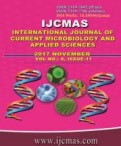


 National Academy of Agricultural Sciences (NAAS)
National Academy of Agricultural Sciences (NAAS)

|
PRINT ISSN : 2319-7692
Online ISSN : 2319-7706 Issues : 12 per year Publisher : Excellent Publishers Email : editorijcmas@gmail.com / submit@ijcmas.com Editor-in-chief: Dr.M.Prakash Index Copernicus ICV 2018: 95.39 NAAS RATING 2020: 5.38 |
Rice cultivation is constantly blamed to be a contributor to climate change through the release of greenhouse gases to the atmosphere especially nitrous oxide, where nitrogenous fertilizers are used injudiciously. A step towards reducing the GHGs emission, an experiment was conducted with eight different soil amendments combinations viz., recommended dose of Fertilizers (RDF), fly ash, biochar, gypsum, Silica Solubilizing Bacteria (SSB), fly ash + SSB, biochar + SSB, gypsum + SSB were studied. Gas collection was done using chambers and samples were analyzed using Gas chromatography. Nitrous oxide emission was observed at active tillering, panicle initiation, 50 per cent flowering and maturity stages. During the crop growth, application of fly ash+ SSB had reduced emission rate followed by fly ash and gypsum + SSB. Higher nitrous oxide emission was found with the treatment of RDF followed by RDF + SSB, biochar, biochar + SSB and gypsum. From the study, it was concluded that application of fly ash + SSB did reduce the nitrous oxide emissions over the application of other soil amendments in rice field.
 |
 |
 |
 |
 |